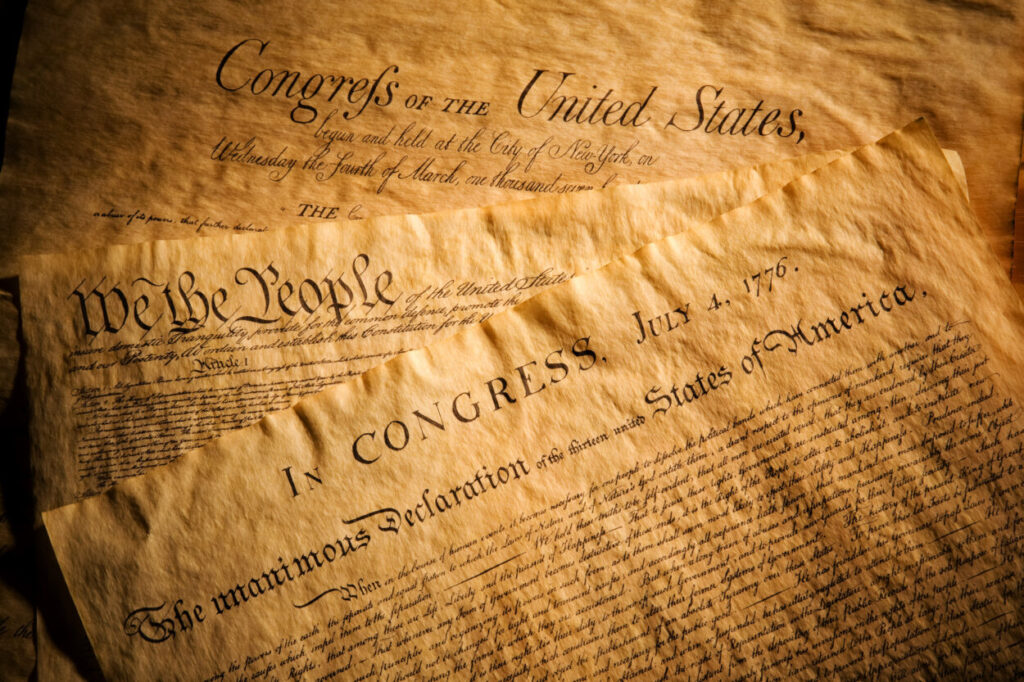Our nations history began long before that of our local community. This page is not meant as a complete history, but as a snapshot by decade of major events, statistics, and growth that add context to the Mountain Home History, Local History, and Regional History pages included on this website.
1770’s
On July 4, 1776, the United States declared its independence from Britain. The new nation which began with 13 colonies solidified its Declaration of Independence and began ……… in September 1783 the U.S. gained what is currently Indiana, Illinois, Kentucky, Michigan, Ohio, Tennessee, Wisconsin, and parts of Alabama, Georgia, Minnesota, Mississippi, North Carolina, Pennsylvania, Virginia, and West Virginia as a result of the Treaty of Paris 1783.

1780’s
On May 17, 1787, delegates begin meeting in Philadelphia to draw up a change to the Articles of Confederation. Eight days into the process, George Washington elected President of the Philadelphia convention. By mid-September the delegates at the Philadelphia convention approved the Constitution and sent it to the Continental Congress. On September 28, 1787, the Continental Congress sent the new Constitution to the states for ratification. By late October the first of the Federalist Papers were published in a New York newspaper, calling for a Bill of Rights (written by Alexander Hamilton, James Madison, and John Jay). In June 1788, the United States Constitution went into effect after the necessary 9 states had ratified it.
The United States House of Representatives holds its 1st full meeting in New York City on April 1, 1789, and before month’s end, George Washington was sworn in as the 1st U.S. President, and John Adams was sworn in as the 1st U.S. Vice President. Before the year ended, the U.S. Congress adopted the Bill of Rights (1st 10 Amendments) and sent to the states for ratification, and the U.S. Army was established.
1790’s
Great progress continued in 1790, the U.S. Coast Guard was established, and the first Census was completed with just over 3.9 million people. The Census of 1790 showed migration into the southern states we know as Kentucky, Virginia, North and South Carolina. In 1791 the Bill of Rights was ratified by 3/4ths of the states and became part of the US Constitution.
In 1792 the U.S. Mint and the U.S. Military Draft were established. With George Washington and John Adams serving their second terms as President and Vice-President, the U.S. Navy was established in 1794 as was the U.S. Postal Service. The US Marine Corps was established in 1798.
1800-1810’s
By 1800 the U.S. population had grown 26% to 5.4 million people with southern and eastern migration continuing into what we know as north central and northeast Tennessee as well as the eastern side of Georgia. There were 1,250 people counted in what we now know as Alabama. In 1801 Thomas Jefferson was sworn in as the 3rd President of the United States. In 1803 the U.S. purchased the Louisiana Territory for $15 million, containing what’s now Arkansas, part of Colorado, Iowa, Louisiana, part of Minnesota, Missouri, part of Montana, part of North Dakota, part of Oklahoma, South Dakota, and part of Wyoming.
By the 1810 Census the population saw its largest growth of the 19th Century to just over 7.2 million people – growing 27% from the previous decade. The unorganized territory of Alabama experienced an 86% growth in population from 1800 to the 1810 Census. Population growth in Tennessee, Georgia, and the north and south of Alabama all seeing significant increases in the 1810 Census. In October 1810 the U.S. annexed what’s now part of Alabama, Louisiana, and Mississippi. In 1819 the U.S. annexed what is now Florida.
In 1812 the young and growing nation faced war yet again. With many volunteering to serve in defense of the Constitution and the American way of life – life, liberty, and the pursuit of happiness. In the latter months of 1814, the British set fire to Washington D.C., and the “Star-Spangled Banner” became the official national Anthem, and the United States and Britain signed the Treaty of Ghent, ending the War of 1812 and with that began an era of good feelings and continued growth.
The Alabama Territory was organized in early March 1817 with St. Stephens along the eastern border chosen as the territorial capital. In 1819 the state organizing convention was held in Huntsville and on December 14, 1819, Alabama was admitted to the Union as the 22nd state with its first permanent capital designated in 1820 at Cahaba in the lower central part of the state. The state encompasses 52,237 square miles.
1820’s
The 1820 U.S. Census counted over 9.6 million people representing a 25% growth from 1810. The Alabama Territory and then state saw an unprecedented growth of 93% with the Madison County area growing to nearly 50 persons per square mile. Alabama wasn’t the only southern state to grow during the decade, Tennessee, and Georgia both grew substantial and westward movement was captured in other unorganized territories.
1830’s
The 1830 U.S. Census continued with 25% growth nationwide with 12.8 million people counted. This included over 53% growth in Alabama growing from 128,000 to over 309,000. Westward and Southern migration continued into more unorganized territories and Tennessee and Georgia, along with Alabama grew significantly. Indian Territory was established by the U.S. in what’s now Oklahoma.
1840’s
1840 was a significant year for DeKalb County as it was the first time it was included in the U.S. Census. The county population recorded was 5,929 people, including 340 slaves. The state of Alabama had grown to 390,756 persons, including 253,532 slaves which was a growth of nearly 48% over 1830. The U.S. population continued the previous 25% growth reaching over 17 million people. The states of Tennessee, Georgia, Alabama, and Mississippi saw significant growth in population with DeKalb County growing to 5-25 persons per square mile. The westward march across organized and unorganized territories continued. The U.S. gained what’s now California, Nevada, Utah, and parts of Arizona, Colorado, New Mexico, and Wyoming because of the Treaty of Guadalupe Hidalgo. It also annexed what’s now parts of Colorado, New Mexico, Kansas, Oklahoma, and Texas through the Adams-Onis Treaty with Spain, and independently annexed the Oregon Territory which contained what’s now Idaho, part of Montana, Oregon, Washington, and part of Wyoming.
1850’s
The U.S. Census of 1850 saw 26% population growth for the country, counting 23,191,876 persons. The state of Alabama saw the last population increase over 50% that it would see during known times, counting 771,623 persons (including 342,844 slaves mostly in the central part of the state), and DeKalb County counted 8,245 persons or 28% (including 506 slaves mostly in the southern valley). Populations continued to grow south and west across the plains and into the west.
During the decade, the 13th, 14th, and 15th Presidents of the United States were sworn into office, and the U.S. purchased what’s now part of Arizona and New Mexico.
1860’s
The U.S. Census of 1860 again experienced a 26% increase in population, counting 31,443,321 persons. The state of Alabama saw a near 39% increase counting 964,201 persons (including 435,000 slaves predominately located in the central to southern locations). DeKalb County rose 23% from the previous decade to 10,705 (including 848 slaves predominantly located in the southern valley location). With the northern part of the county reaching 10-25 persons per square mile and the southern valley area reaching 25-50 persons per square mile.
The census clearly indicated the drive west is still underway and the country was growing every day, however, few if any knew at the time that unrest, division, and war at home was almost at the door.
On January 11, 1861, Alabama was the 4th state to secede from the Union and Civil War seemed imminent. Three weeks later the Confederate States of America was formed. And on the same date of February 4th, the Apache declared war on the United States. Two weeks later Jefferson Davis was sworn in as the 1st President of the Confederate States of America.
Abraham Lincoln was sworn in as the 16th President of the United States on March 4, 1861. During the following two months, the Confederate Congress adopted a constitution, their forces began an assault on Fort Sumpter, the Union blockade of Confederate ports was initiated, and President Abraham Lincoln declared a state of insurrection in the southern states. The march toward war had reached its destination.
In May, as battles ensued, Richmond, Virginia became the official capital city of the Confederate States. Yet as the war raged throughout the country, life continued as best possible, and people still moved their families to northern DeKalb County.
1870’s
The U.S. Census of 1870 only showed an 18% growth (attributed greatly to the loss of life during the Civil War), growing to 38.5 million. The state of Alabama grew 22.6%, down 16% from 1860, to just shy of 997,000, again attributed to the significant loss of life during the war. The population counted in DeKalb County was a mere 7,126, significantly less than the 10,705 counted in 1860.
The process of reconstruction reached fulfillment and Ulysses Grant was sworn into office for a second term as President of the United States on March 4, 1873. Thus began the period known as Expansion was underway. The 19th President of the United States was sworn in on March 4, 1877.
1880’s
The U.S. Census of 1880 showed 23% growth, a 5% increase over 1870 in the post Civil War Census. The country grew to 50.2 million people. The state of Alabama grew 23.6% to just over 1.2 million people. The population counted in DeKalb County was on the rise up 44% from 1870, counted at 12,675 persons. The county averaged 16.3 persons per square mile, the greatest population density since its founding in 1836.
1890’s
The U.S. Census of 1890 showed 20% growth, counting nearly 63 million people. The state of Alabama outpaced national growth by 14%, reaching a 34% growth to count just over 1.5 million people. The population counted in DeKalb County outpaced the state growth rate coming in at 40%, counting over 21,000 persons. The county averaged 27.2 persons per square mile.
The United States elected the 24th and 25th President’s, but peace would illude the Union as it declared war on Spain in April 1898, marking the beginning of the Spanish American War.
With U.S. victories at Manila Bay and Santiago before the heat of summer, U.S. annex of Hawaii and invasion of Puerto Rico, an armistice was signed between the United States and Spain in August 1898. The armistice led to the 1898 Treaty of Paris marking the official end of the Spanish-American War.
In the closing months of the decade, the United States annexed Guam, the Philippines, and Puerto Rico, marking the beginning of a period known as The American Empire.
This page will amended and subsequent decades added as time permits.

